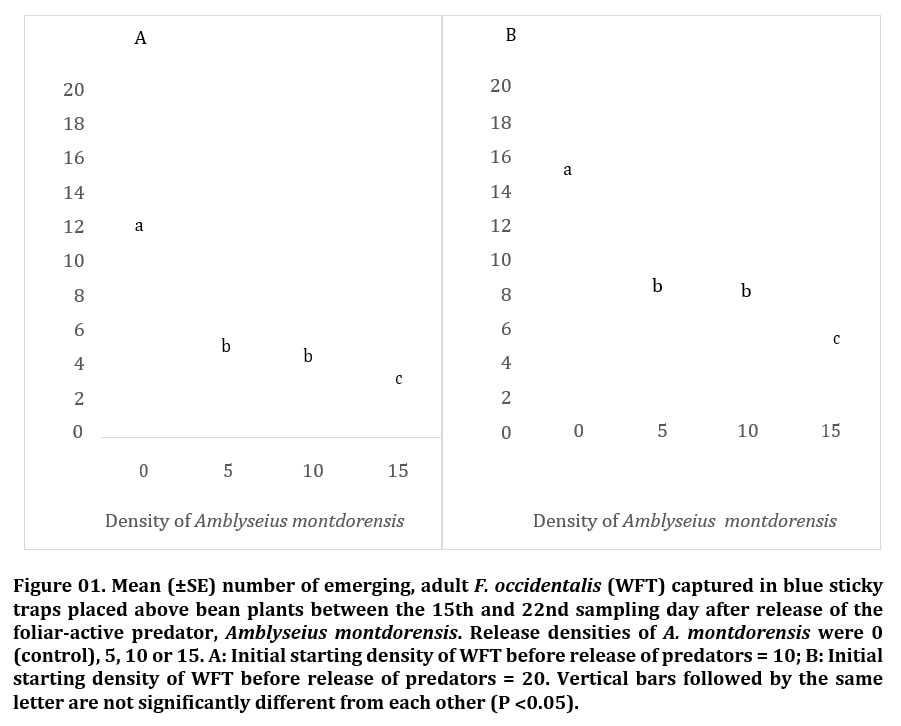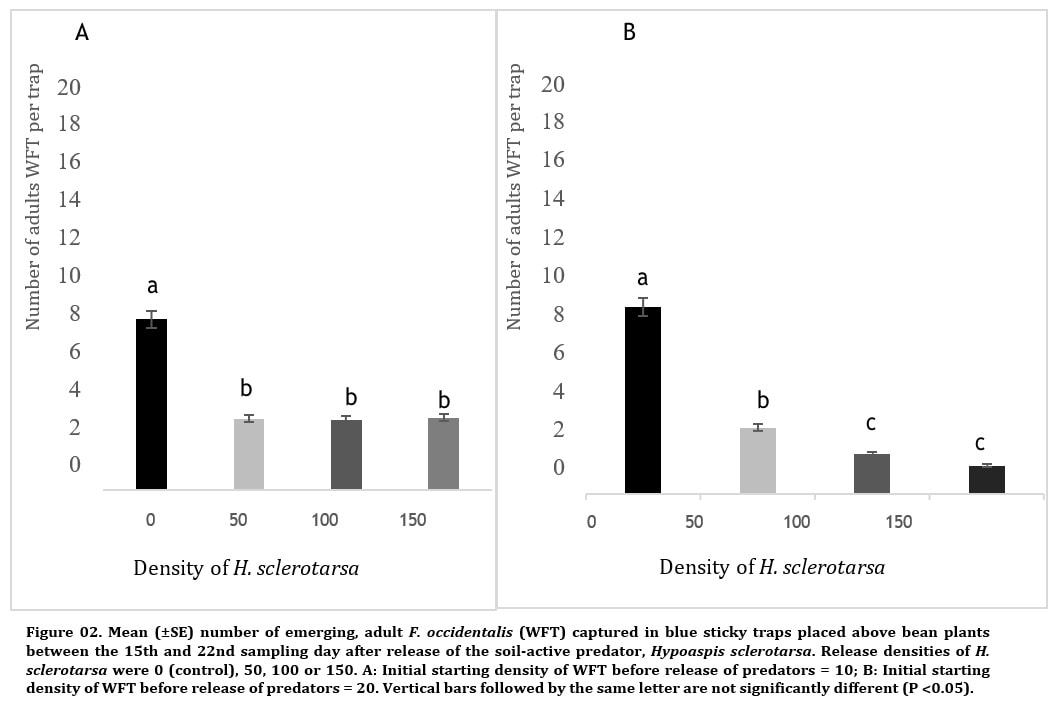J. Mol. Stud. Med. Res. | Volume 04, Issue 01, 169-176| https://doi.org/10.18801/jmsmr.040119.19
Article type: Research article, Received: 05.01.2019, Revised: 24.03.2019, Date of Publication: 25 April 2018.
Article type: Research article, Received: 05.01.2019, Revised: 24.03.2019, Date of Publication: 25 April 2018.
Combining foliar and soil-active predatory mites (Amblyseius montdorensis and Hypoaspis sclerotarsa) to improve thrips control
Ruth Murunde¹, Henry Wainwright² and Losenge Turoop¹
¹Dept. of Horticulture, Jomo Kenyatta University of Agriculture and Technology, Nairobi, Kenya.
²Real IPM Company Ltd. Madaraka, Thika, Kenya.
¹Dept. of Horticulture, Jomo Kenyatta University of Agriculture and Technology, Nairobi, Kenya.
²Real IPM Company Ltd. Madaraka, Thika, Kenya.
Abstract
In three separate greenhouse experiments we evaluated the effect of different densities of the mites Amblyseius montdorensis (foliar predator; AM at 0, 5, 10 or 15 per pot), different densities of Hypoaspis sclerotarsa (ground predator; HS at 0. 50, 100 or 150 per pot) or a combination of the two (0AM, 0HS; 15AM, 50HS; 15AM, 100HS; 15AM, 150HS) on emergence of western flower thrips (WFT), Frankliniella occidentalis Pergande (Thysanoptera: Thripidae) from soil; initial start populations of WFT were either small (10) or large (20). A completely randomized design was used and for each experiment there were three replicates per treatment and the experiment was repeated on two occasions. Single applications of A. montdorensis, H. sclerotarsa or a combination of both all had an impact on the number of WFT emerging compared with the control. There was a significant effect of A. montdorensis density on the number of WFT emerging from the soil (F=0.31, P= 0.420 df =1). There was no significant difference in the population densities of WFT emerging from soil in the control and following release of H. sclerotarsa when initial release densities of WFT at the two initial prey densities of 10 and 20. Combined use of A. montdorensis and H. sclerotarsa at a density of 150 with 15 A. montdorensis reduced adult WFT emergence at density of 20 WFT. These findings highlight the potential for a combined use of A. montdorensis with H. sclerotarsa for the control of soil-dwelling stages of thrips.
Key Words: Hypoaspis sclerotarsa, Pupae, Biocontrol, Frankliniella occidentalis and Amblyseius montdorensis
In three separate greenhouse experiments we evaluated the effect of different densities of the mites Amblyseius montdorensis (foliar predator; AM at 0, 5, 10 or 15 per pot), different densities of Hypoaspis sclerotarsa (ground predator; HS at 0. 50, 100 or 150 per pot) or a combination of the two (0AM, 0HS; 15AM, 50HS; 15AM, 100HS; 15AM, 150HS) on emergence of western flower thrips (WFT), Frankliniella occidentalis Pergande (Thysanoptera: Thripidae) from soil; initial start populations of WFT were either small (10) or large (20). A completely randomized design was used and for each experiment there were three replicates per treatment and the experiment was repeated on two occasions. Single applications of A. montdorensis, H. sclerotarsa or a combination of both all had an impact on the number of WFT emerging compared with the control. There was a significant effect of A. montdorensis density on the number of WFT emerging from the soil (F=0.31, P= 0.420 df =1). There was no significant difference in the population densities of WFT emerging from soil in the control and following release of H. sclerotarsa when initial release densities of WFT at the two initial prey densities of 10 and 20. Combined use of A. montdorensis and H. sclerotarsa at a density of 150 with 15 A. montdorensis reduced adult WFT emergence at density of 20 WFT. These findings highlight the potential for a combined use of A. montdorensis with H. sclerotarsa for the control of soil-dwelling stages of thrips.
Key Words: Hypoaspis sclerotarsa, Pupae, Biocontrol, Frankliniella occidentalis and Amblyseius montdorensis
Article Full-Text PDF
| 19.01.04.19_combining_foliar_and_soil-active_predatory_mites__amblyseius_montdorensis_and_hypoaspis_sclerotarsa__to_improve_thrips_control.pdf | |
| File Size: | 901 kb |
| File Type: | |
Article Metrics
|
Share This Article
|
|
Article Citations
MLA
Murunde et al. “Combining foliar and soil-active predatory mites (Amblyseius montdorensis and Hypoaspis sclerotarsa) to improve thrips control.” Journal of Molecular Studies and Medicine Research 04(01) (2019): 169-176.
APA
Murunde, R. Wainwright, H. and Turoop, L. (2019). Combining foliar and soil-active predatory mites (Amblyseius montdorensis and Hypoaspis sclerotarsa) to improve thrips control. Journal of Molecular Studies and Medicine Research, 04(01), 169-176.
Chicago
Murunde, R. Wainwright, H. and Turoop, L. “Combining foliar and soil-active predatory mites (Amblyseius montdorensis and Hypoaspis sclerotarsa) to improve thrips control.” Journal of Molecular Studies and Medicine Research 04(01) (2019): 169-176.
Harvard
Murunde, R. Wainwright, H. and Turoop, L. 2019. Combining foliar and soil-active predatory mites (Amblyseius montdorensis and Hypoaspis sclerotarsa) to improve thrips control. Journal of Molecular Studies and Medicine Research, 04(01), pp. 169-176.
Vancouver
Murunde, R, Wainwright, H and Turoop, L. Combining foliar and soil-active predatory mites (Amblyseius montdorensis and Hypoaspis sclerotarsa) to improve thrips control. Journal of Molecular Studies and Medicine Research. 2019 April 04(01):169-176.
Murunde et al. “Combining foliar and soil-active predatory mites (Amblyseius montdorensis and Hypoaspis sclerotarsa) to improve thrips control.” Journal of Molecular Studies and Medicine Research 04(01) (2019): 169-176.
APA
Murunde, R. Wainwright, H. and Turoop, L. (2019). Combining foliar and soil-active predatory mites (Amblyseius montdorensis and Hypoaspis sclerotarsa) to improve thrips control. Journal of Molecular Studies and Medicine Research, 04(01), 169-176.
Chicago
Murunde, R. Wainwright, H. and Turoop, L. “Combining foliar and soil-active predatory mites (Amblyseius montdorensis and Hypoaspis sclerotarsa) to improve thrips control.” Journal of Molecular Studies and Medicine Research 04(01) (2019): 169-176.
Harvard
Murunde, R. Wainwright, H. and Turoop, L. 2019. Combining foliar and soil-active predatory mites (Amblyseius montdorensis and Hypoaspis sclerotarsa) to improve thrips control. Journal of Molecular Studies and Medicine Research, 04(01), pp. 169-176.
Vancouver
Murunde, R, Wainwright, H and Turoop, L. Combining foliar and soil-active predatory mites (Amblyseius montdorensis and Hypoaspis sclerotarsa) to improve thrips control. Journal of Molecular Studies and Medicine Research. 2019 April 04(01):169-176.
References
- Bennison, J. A. Maulden, K. and Maher, H. (2002). Choice of predatory mites for biological control of ground-dwelling stages of western flower thrips within a ‘push–pull’ strategy on pot chrysanthemum. IOBC (WPRS) Bull. 25, 9–12.
- Berndt, O. Meyhöfer, R. and Poehling, H. M. (2004). The edaphic phase in the ontogenesis of Frankliniella occidentalis and comparison of Hypoaspis miles and H. aculeifer as predators of soil-dwelling thrips stages. Biol. Control, 30, 17–24. https://doi.org/10.1016/j.biocontrol.2003.09.009
- Frescata, C. and Mexia, A. (1996) Biological control of thrips (Thysanoptera) by Orius laevigatus (Heteroptera: Anthocoridae) in organically grown strawberries. Biol. Agric. Hort. 13, 141–148. https://doi.org/10.1080/01448765.1996.9754773
- Gillespie, D. R. and Quiring, D. M. J. (1990). Biological control of fungus gnats, Bradysia spp. and western flower thrips, Frankliniella occidentalis, in glasshouses using a soil dwelling predatory mite, Geolaelaps sp. nr aculeifer. Can. Entomol. 122, 975–983. https://doi.org/10.4039/Ent122975-9
- Gillespie, D. R. and Ramey, C. A. (1988). Life history and cold storage of Amblyseius cucumeris (Acarina: Phytoseiidae). J. Entomol. Soc. Bri. Colom. 85, 71–76.
- Karg, W. (1993). Die Tierwelt Deutschlands. Teil 59. Acari (Acarina), Milben Parasitiformes (Anactinochaeta) Cohors Gamasia Leach. Raubmilben. Gustav Fischer Verlag. pp. 1-523.
- Lewis, T. (1997). Chemical control. In: Lewis, T. (ed), Thrips as Crop Pests. CAB International, Wallingford. pp. 567–594.
- Loomans, A. J. M. and van Lenteren, J. C. (1995). Biological control of thrips: A review on thrips parasitoids. Biological Control of Thrips pests. Wageningen Agri. Univ. Papers, 95, 92–182.
- Losey, J. E. and Denno, R. F. (1998a). Interspecific variation in the escape responses of aphids: effect on risk of predation from foliar-foraging and ground-foraging predators. Oecologia, 115, 245–252. https://doi.org/10.1007/s004420050513
- Losey, J. E. and Denno, R. F. (1998b). Positive predator–predator interactions: enhanced predation rates and synergistic suppression of aphid populations. Ecology, 79, 2143–2152. https://doi.org/10.1890/0012-9658(1998)079[2143:PPPIEP]2.0.CO;2
- Michelakis, S. E. and Amri, A. (1997). Integrated control of Frankliniella occidentalis in Crete-Greece. IOBC (SROP) Bull. 20, 169–176.
- Ramakers, P. M. J. (1995). Biological control using oligophagous predators. In: B.L. Parker, M. Skinner and T. Lewis (eds), Thrips Biology and Management. Plenum Press, New York. pp. 225–229. https://doi.org/10.1007/978-1-4899-1409-5_33
- Riudavets, J. (1995). Predators of Frankliniella occidentalis Pergande and Thrips tabaci Lind.: a review. Wageningen Agri. Univ. Papers, 95, 1–42.
- Sabelis, M. W. and van Rijn, P. C. J. (1997). Predation by insects and mites. In: Lewis, T. (ed), Thrips as Crop Pests. CAB, Wallingford, UK. pp. 259–354.
- SAS Institute Inc. (1999). SAS/STAT User's Guide: Version 8, Volume 2, Cary, NC: SAS Institute Inc.
- Teerling, C. R. (1995). Chemical ecology of western flower thrips. In: Parker, B. L. Skinner, M. and Lewis, T. (eds). Thrips Biology and Management. Plenum Press, New York. pp. 439–447. https://doi.org/10.1007/978-1-4899-1409-5_69
- Teerling, C. R. Pierce, H. D. Borden, J. H. and Gillespie, D. R. (1993). Identification and bioactivity of alarm pheromone in the western flower thrips, Frankliniella occidentalis. J. Chem. Ecol. 19, 681–697. https://doi.org/10.1007/BF00985001
- Tommasini, M. G. and Maini, S. (1995) Frankliniella occidentalis and other thrips harmful to vegetables and ornamental crops in Europe. Wageningen Agri. Univ. Papers, 95, 1–42.
- Van Lenteren, J. C. and Loomans, A. J. M. (1998) Is there a natural enemy good enough for biological control of thrips. British Crop Protection Conference. Pests and Diseases. British Crop Protection Council, Brighton, UK, 16–19 November. pp. 401–408.
- Varatharajan, R. and Daniel, A. M. (1984). Studies on soil pupation in some phytophagous thrips. J. Soil Biol. Ecol. 4, 116–123.
- Wright, E. M. and Chambers, R. J. (1994). The biology of the predatory mite Hypoaspis miles (Acari: Laelapidae), a potential biological control agent of Bradysia paupera (Diptera: Sciaridae). Entomophaga, 39, 225–235. https://doi.org/10.1007/BF02372360
© 2018 The Authors. This article is freely available for anyone to read, share, download, print, permitted for unrestricted use and build upon, provided that the original author(s) and publisher are given due credit. All Published articles are distributed under the Creative Commons Attribution 4.0 International License.

